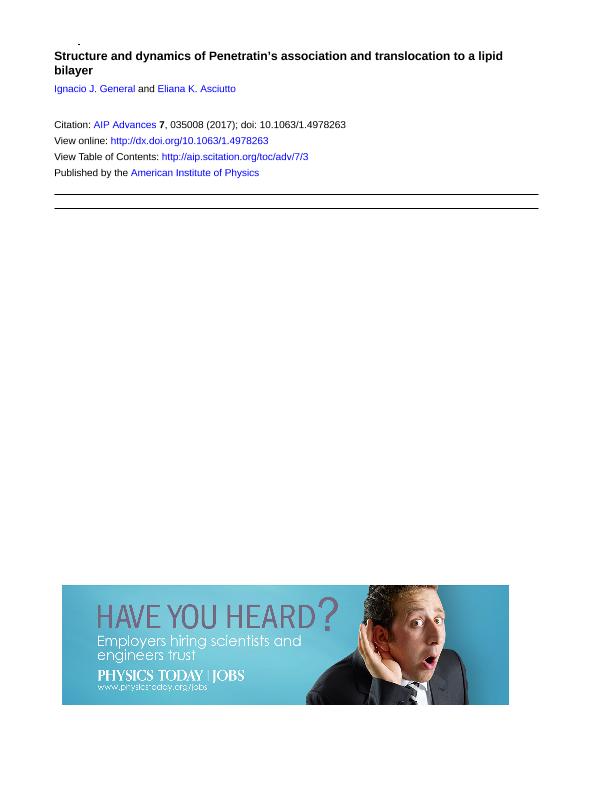Mostrar el registro sencillo del ítem
dc.contributor.author
General, Ignacio

dc.contributor.author
Asciutto, Eliana Karina

dc.date.available
2019-06-04T20:38:22Z
dc.date.issued
2017-03
dc.identifier.citation
General, Ignacio; Asciutto, Eliana Karina; Structure and dynamics of Penetratin?s association and translocation to a lipid bilayer; American Institute of Physics Inc.; AIP Advances; 7; 3; 3-2017; 1-11
dc.identifier.issn
2158-3226
dc.identifier.uri
http://hdl.handle.net/11336/77605
dc.description.abstract
Penetratin belongs to the important class of small and positively charged peptides, capable of entering cells. The determination of the optimal peptidic structure for translocation is challenging; results obtained so far are varied and dependent on several factors. In this work, we review the dynamics of association of Penetratin with a modeled dioleoyl-phosphatidylcholine (DOPC) lipid membrane using molecular dynamics simulations with last generation force fields. Penetratin's structural preferences are determined using a Markov state model. It is observed that the peptide retains a helical form in the membrane associated state, just as in water, with the exception of both termini which lose helicity, facilitating the interaction of terminal residues with the phosphate groups on the membrane's outer layer. The optimal orientation for insertion is found to be with the peptide's axis forming a small angle with the interface, and with R1 stretching toward the bilayer. The interaction between arginine side-chains and phosphate groups is found to be greater than the corresponding to lysine, mainly due to a higher number of hydrogen bonds between them. The free energy profile of translocation is qualitatively studied using Umbrella Sampling. It is found that there are different paths of penetration, that greatly differ in size of free energy barrier. The lowest path is compatible with residues R10 to K13 leading the way through the membrane and pulling the rest of the peptide. When the other side is reached, the C-terminus overtakes those residues, and finally breaks out of the membrane. The peptide's secondary structure during this traversal suffers some changes with respect to the association structure but, overall, conserves its helicity, with both termini in a more disordered state.
dc.format
application/pdf
dc.language.iso
eng
dc.publisher
American Institute of Physics Inc.
dc.rights
info:eu-repo/semantics/openAccess
dc.rights.uri
https://creativecommons.org/licenses/by-nc-sa/2.5/ar/
dc.subject
Peptides
dc.subject
Lipids
dc.subject
Free Energy
dc.subject
Cell Membranes
dc.subject.classification
Astronomía

dc.subject.classification
Ciencias Físicas

dc.subject.classification
CIENCIAS NATURALES Y EXACTAS

dc.title
Structure and dynamics of Penetratin?s association and translocation to a lipid bilayer
dc.type
info:eu-repo/semantics/article
dc.type
info:ar-repo/semantics/artículo
dc.type
info:eu-repo/semantics/publishedVersion
dc.date.updated
2019-06-04T14:40:25Z
dc.journal.volume
7
dc.journal.number
3
dc.journal.pagination
1-11
dc.journal.pais
Estados Unidos

dc.journal.ciudad
Melville
dc.description.fil
Fil: General, Ignacio. Consejo Nacional de Investigaciones Científicas y Técnicas; Argentina. Universidad Nacional de San Martín. Escuela de Ciencia y Tecnología; Argentina
dc.description.fil
Fil: Asciutto, Eliana Karina. Consejo Nacional de Investigaciones Científicas y Técnicas; Argentina. Universidad Nacional de San Martín. Escuela de Ciencia y Tecnología; Argentina
dc.journal.title
AIP Advances
dc.relation.alternativeid
info:eu-repo/semantics/altIdentifier/doi/http://dx.doi.org/10.1063/1.4978263
dc.relation.alternativeid
info:eu-repo/semantics/altIdentifier/url/https://aip.scitation.org/doi/10.1063/1.4978263
Archivos asociados
